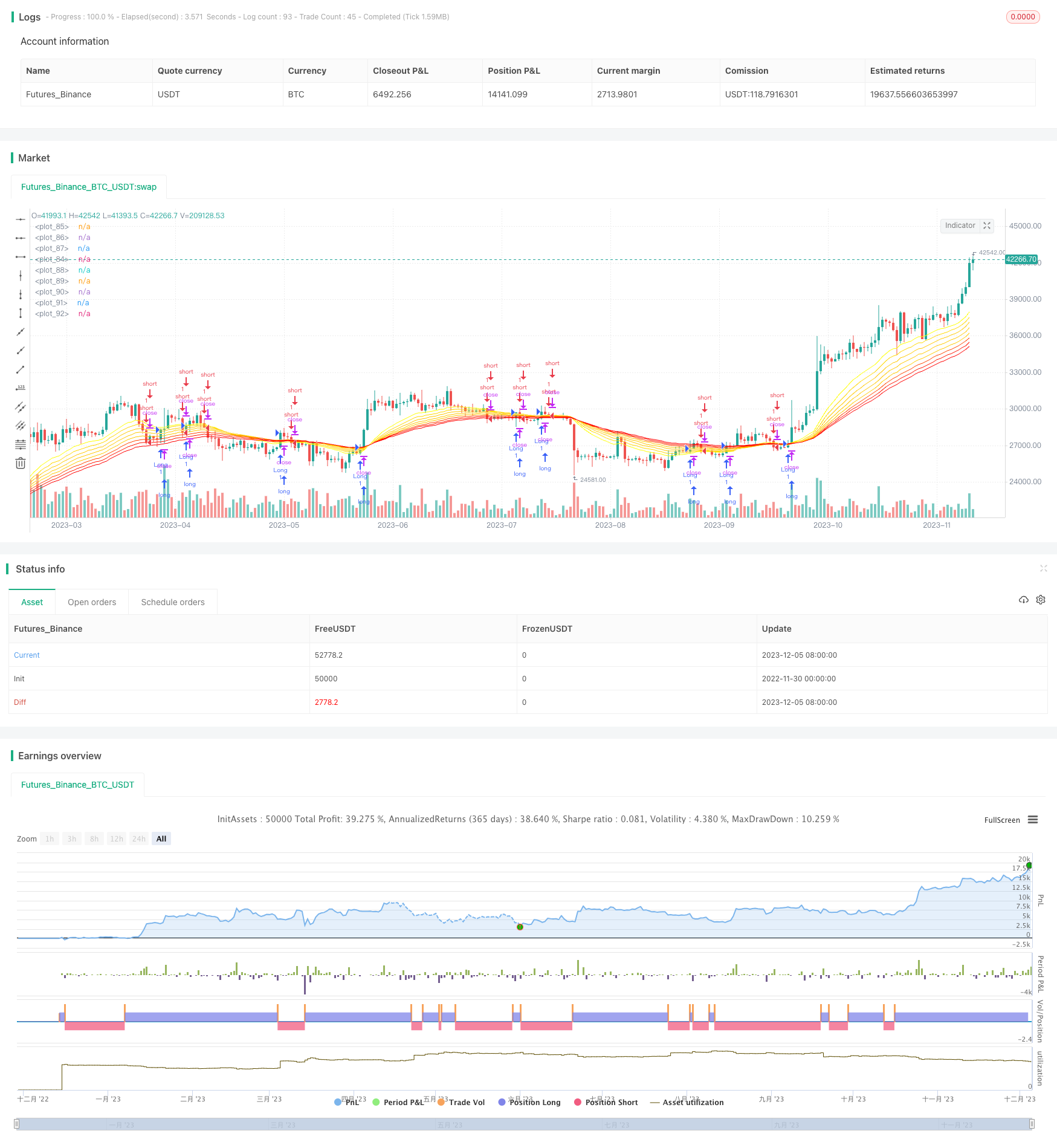
概述
本策略通过计算多个不同周期的移动平均线,结合黄金交叉形态来判断趋势方向,实现趋势跟踪交易。主要功能是发现价格趋势转折点,发出买入和卖出信号。
策略原理
该策略基于35周期的EMA作为主要判断买入卖出的指标。当价格上穿35EMA时,产生买入信号;当价格下破35EMA时,产生卖出信号。此外,该策略同时绘制了8条不同周期的EMA组成的EMA带,辅助判断趋势方向。越低周期的EMA离价格越近,能更快捕捉价格变化;越高周期的EMA跟随价格变化越缓慢,能过滤掉部分噪音。EMA带能清楚描绘出价格的主要趋势方向。
该策略主要依赖35EMA判断价格主要趋势。当价格上穿或下穴35EMA时就产生交易信号。EMA带则主要起到辅助判断和优化入场timing的作用。
优势分析
该策略结合趋势判断和频繁交易之间的平衡。35EMA既能基本判断主要趋势方向变换,也不会太滞后,基本能在价格转折点附近产生交易信号。而EMA带形成的趋势通道,能辅助判断买入卖出的机会,优化入场的时机。
相比单一EMA指标判断,该策略能提供更全面和清晰的趋势判断。不同周期EMA的组合既保证了对大周期趋势方向的判断,又通过高低频EMA结合平滑了部分短周期市场噪音的影响。
用户可以自行调整参数,改变主要交易指标35EMA的周期,或EMA带中的EMA周期,优化自身的交易风格。整体来说,该策略提供了相对精准和全面的趋势交易方案。
风险分析
该策略主要风险在于用户的参数选择。如果选择的EMA周期太短,则会增加交易频率和交易风险。如果EMA周期太长,则会错过价格转折点,不能及时入场。
另一个主要风险是在盘整行情中,EMA指标会产生多次错误信号。这时用户需要辅助判断趋势方向,避免盲目入场。
最后一个风险点是在剧烈行情中,指标会发生滞后,不能及时发出买入卖出信号。这时用户需要提前判断,不能完全依赖指标信号。
优化方向
该策略主要优化方向是调整EMA参数,适配不同市场和交易者风格。具体来说,可以从以下几个方面入手:
- 调整主要交易指标35EMA的周期参数,优化获取交易信号的时机
- 调整EMA带中的各EMA周期参数,优化对趋势的判断
- 添加其他辅助指标结合判断,如BOLL通道、KDJ指标等
- 结合交易量指标,避免在价格剧烈波动但交易量不增长的情况下入场
通过参数调整和多个指标结合,可以进一步提高策略的稳定性和获取信号的准确性。从而降低交易风险,获得更好的回报。
总结
该策略通过计算多条不同周期的EMA并辅以EMA带判断,实现了相对准确和全面的趋势跟踪交易方案。它既考虑了捕捉价格转折的及时性,也综合判断了不同级别的趋势走向,在追求交易频率与系统稳定性之间取得了平衡。通过参数调整与优化,该策略可以适应不同市场环境、资产类型以及交易者风格。它为用户量化交易提供了一个相对成熟和强大的基础解决方案。
/*backtest
start: 2022-11-30 00:00:00
end: 2023-12-06 00:00:00
period: 1d
basePeriod: 1h
exchanges: [{"eid":"Futures_Binance","currency":"BTC_USDT"}]
*/
//
// @author d3nv3r
// @inspiration [LazyBear]
// List of all my indicators: https://github.com/d3nv3r0ne/tradingview
//
// Inputs : Show Buy&Sell Signals
// Inputs : Show EMA in White for the Buy&Sell Signals
// Inputs : Choose the length of the EMA for the B&S signals
//
// How to use it :
// Any chart
// copy all and paste the content into the Pine Editor Tab at the bottom of the tradingview pannel
// [Save As...] and [Add to Chart] in top-right of the Pine Editor
//
//@version=4
strategy(shorttitle = "35EMA_X_B/S_RIBBON", title="35EMA Cross BuyAndSell Strategy + RIBBON [d3nv3r]", overlay=true)
//
// Variables inputs
//
useBSstrategy = input(true, title="Show Buy & Sell Strategy")
showMABS = input(true, title="Show EMA Cross - need to active B&S Strategy")
lengthBS = input(title="Length EMA Cross - need to active B&S Strategy", type=input.integer, defval=35, minval=1)
src = input(close, title="Source")
//
// Variables
// Ribbon EMA + EMA B/S
//
lenRib1 = 20
lenRib2 = 25
lenRib3 = 30
lenRib4 = 35
lenRib5 = 40
lenRib6 = 45
lenRib7 = 50
lenRib8 = 55
//
// Variables
// Quadruple SMA + SMA B/S
//
maBS = ema(src, lengthBS)
rib1 = ema(src, lenRib1)
rib2 = ema(src, lenRib2)
rib3 = ema(src, lenRib3)
rib4 = ema(src, lenRib4)
rib5 = ema(src, lenRib5)
rib6 = ema(src, lenRib6)
rib7 = ema(src, lenRib7)
rib8 = ema(src, lenRib8)
//
// Variables color
//
colorEMAX = #FFFFFF
colorRib1 = #FFFF00
colorRib2 = #FFD700
colorRib3 = #FFC800
colorRib4 = #FFC800
colorRib5 = #FFC800
colorRib6 = #FF4500
colorRib7 = #FF1500
colorRib8 = #FF0000
//
// Variables Buy/Sell
//
longCondition = crossover(close,maBS)
shortCondition = crossunder(close,maBS)
//
// Logic Buy/Sell
//
if (useBSstrategy)
if (longCondition)
strategy.entry("Long", strategy.long)
if (shortCondition)
strategy.entry("short", strategy.short)
//
// Plot Quadruple SMA + SMA B/S
//
plot(showMABS and maBS ? maBS : na, color=colorEMAX, transp=0, linewidth=2)
plot(rib1, color=colorRib1, transp=15, linewidth=1)
plot(rib2, color=colorRib2, transp=15, linewidth=1)
plot(rib3, color=colorRib3, transp=15, linewidth=1)
plot(rib4, color=colorRib4, transp=15, linewidth=1)
plot(rib5, color=colorRib5, transp=15, linewidth=1)
plot(rib6, color=colorRib6, transp=15, linewidth=1)
plot(rib7, color=colorRib7, transp=15, linewidth=1)
plot(rib8, color=colorRib8, transp=15, linewidth=1)